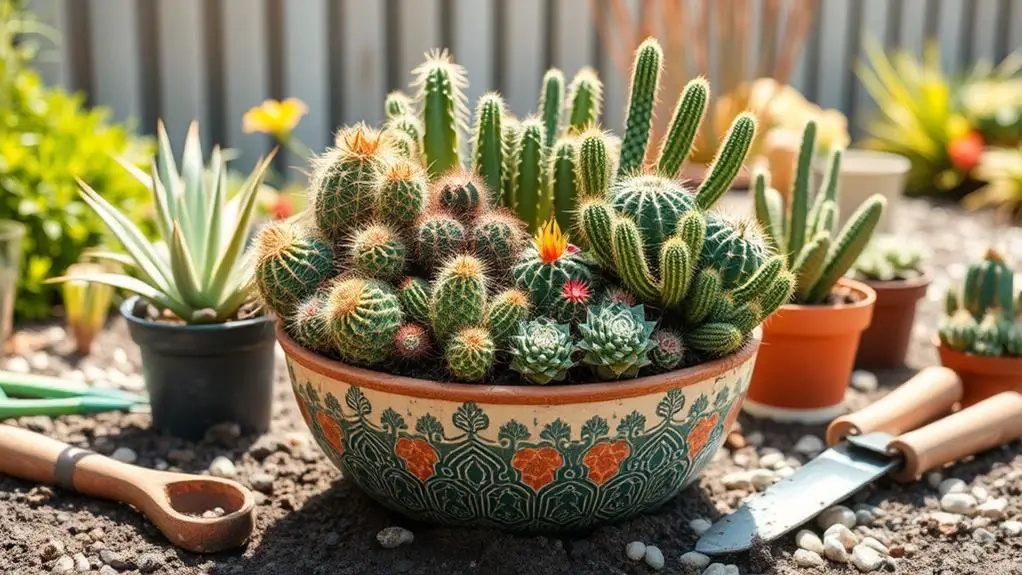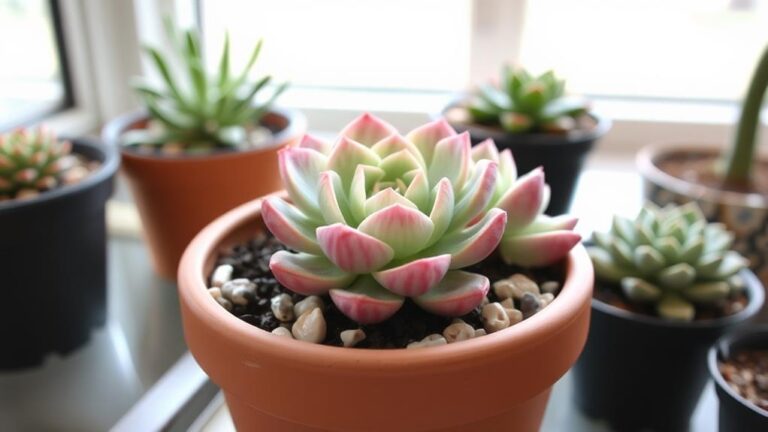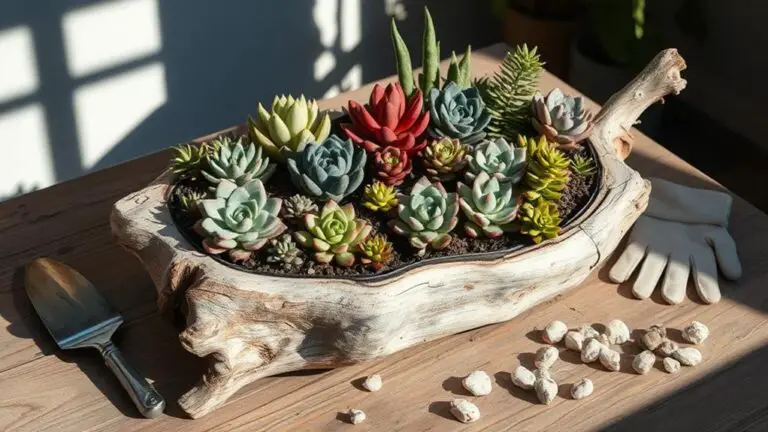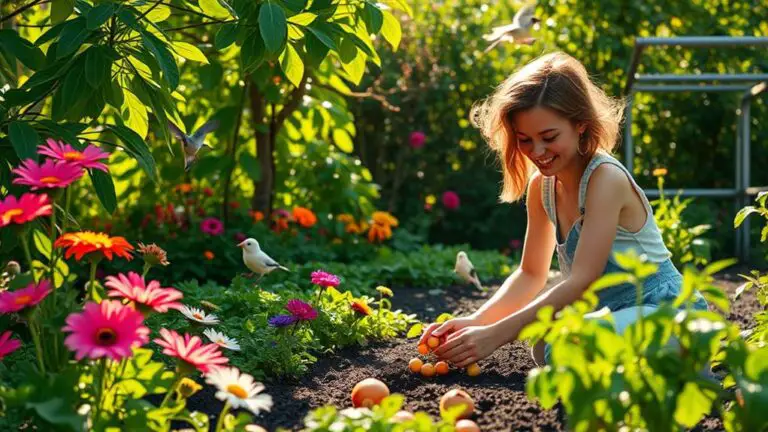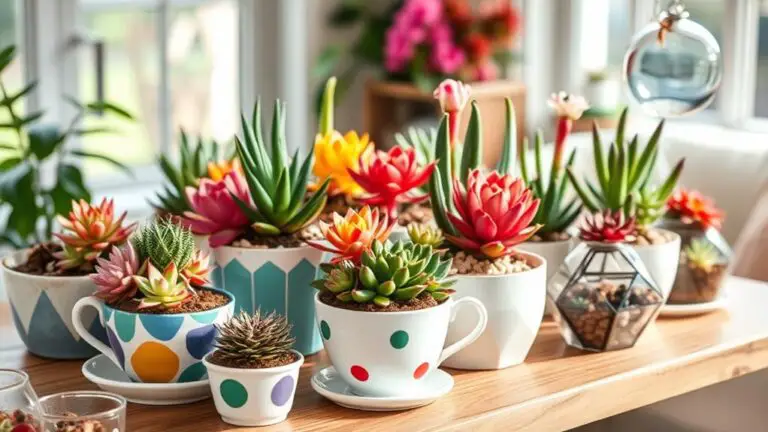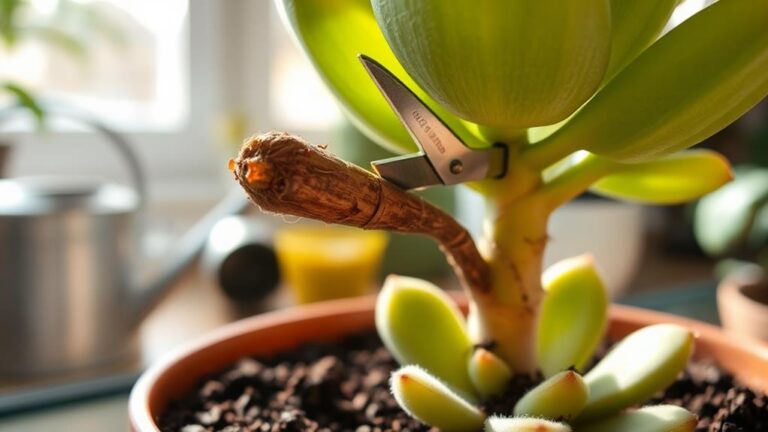Planting Cacti and Succulents Together Guide
When you're considering planting cacti and succulents together, understanding their needs is vital for a thriving display. Both types of plants have unique characteristics, yet they share similarities that make them compatible companions. Start by selecting a wide, shallow pot with excellent drainage to prevent root rot. Position taller cacti at the back and shorter succulents in front to create depth and visual interest. But what soil mix should you use, and how do you manage watering practices to guarantee healthy growth? Let's explore these essential steps to create a vibrant, low-maintenance arrangement.
Understanding Cacti and Succulents

When you're diving into the world of cacti and succulents, it's crucial to grasp their fundamental differences and similarities. Knowing these can help you care for them better.
Both cacti and succulents are amazing plants that thrive in arid environments. They've adapted to store water in their leaves and stems, which helps them survive in drought conditions.
Cacti belong to the Cactaceae family. While all cacti are succulents, not all succulents are cacti. This is a key detail to remember.
One way to identify a cactus is by its areoles. These are unique structures from which spines, branches, and flowers grow. Other succulents don't have these areoles.
Cacti also have a special way of photosynthesis, using their stems to do the job. This method helps them save water more effectively than many other succulents.
Generally, cacti can handle intense light and need less frequent watering compared to other succulents.
Understanding these basics will make you more confident in planting and caring for cacti and succulents.
With the right knowledge, you can create a thriving garden that showcases the beauty of these resilient plants.
Differences and Similarities
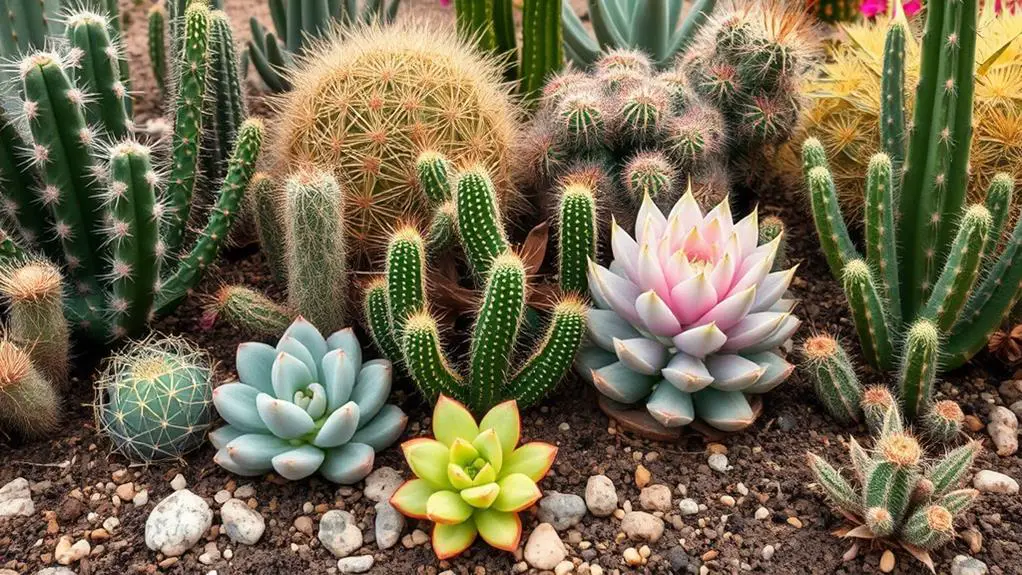
Understanding the differences and similarities between cacti and succulents can help you care for them more effectively. Both cacti and succulents are wonderful plants that store water in their leaves and stems, allowing them to thrive in arid conditions. When you plant cacti and succulents together, knowing their unique traits can make a big difference in their care.
First, let's look at the differences between cacti and succulents. Cacti belong to the Cactaceae family, and they've special structures called areoles. These areoles are where their spines, branches, and flowers grow.
Succulents, on the other hand, don't have areoles. Another key difference is how they perform photosynthesis. Cacti use their stems for this process, which helps them conserve water better. Succulents typically rely on their leaves for photosynthesis.
Despite these differences, cacti and succulents share many similarities. Both are adapted to survive with minimal water and can store it efficiently.
However, cacti generally need less frequent watering and can handle more direct sunlight. Succulents often prefer a bit more moisture and indirect light.
Choosing the Right Pot

Knowing the differences and similarities between cacti and succulents helps you care for them better. When choosing the right pot, start by ensuring it has generous drainage holes. These holes are essential to prevent waterlogging, which can lead to root rot. Without proper drainage, your plants may suffer, so always check for this feature first.
Opt for wide and shallow pots. These provide enough space for your plants' root systems to grow while allowing better air circulation around the roots. Terracotta or ceramic pots are great choices because they promote faster evaporation of excess moisture compared to plastic ones, keeping the soil mix just right for your plants.
The pot's aesthetic appeal is also important. Choose a design that complements the colors and textures of your cacti and succulents, creating a cohesive look.
If you find a pot without drainage holes that you love, don't worry. You can create a well-draining soil layer by adding pebbles at the bottom, enhancing overall drainage.
Essential Gardening Supplies
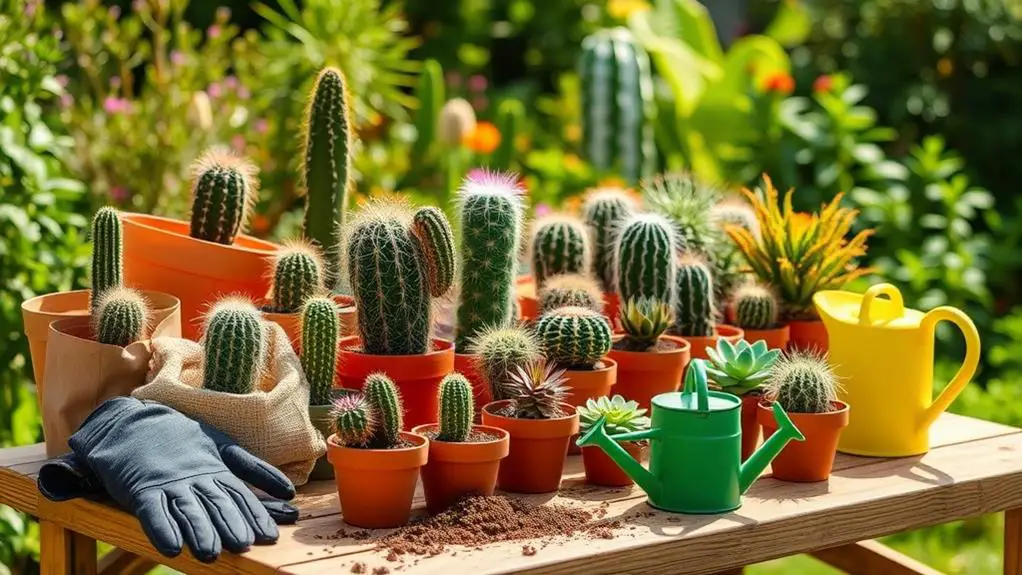
To successfully plant cacti and succulents, you'll need a few essential gardening supplies. First, select a pot with good drainage. This means it should have holes at the bottom to let water escape, preventing root rot. Pots made from porous materials, like handmade ceramic or terracotta, are ideal because they enhance drainage and keep your plants healthy.
Next, you'll need fast-draining succulent soil. This special soil mix is designed to let water flow through quickly, which is crucial for cacti and succulents. Regular potting soil holds too much water, which can harm these plants.
Gather tools like scissors, tweezers, and a soft bristle brush. These help you handle your plants carefully without damaging them. Using drywall mesh tape at the bottom of your pot can aid in retaining the soil while still allowing water to drain properly.
A scoop tool is also handy for placing soil around the roots. This guarantees your plants are secure and your workspace stays clean.
Don't forget thick gardening gloves to protect your hands from cactus spines.
Preparing the Plants
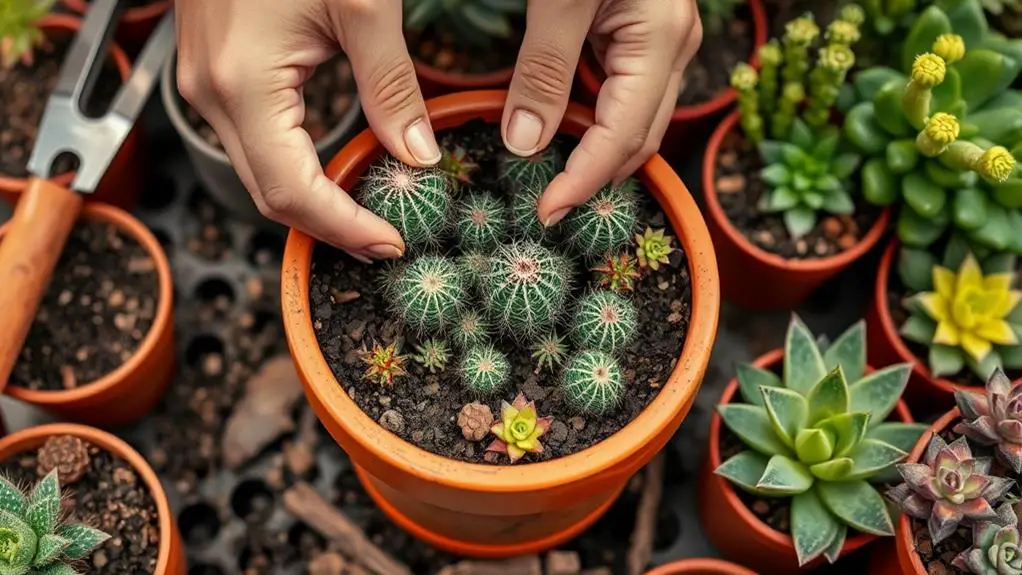
Before you start planting, check your cacti and succulents for any pests, and trim any damaged roots to promote healthy growth.
It's also a good idea to give them a light watering, ensuring they're hydrated before they go into the soil.
Taking these steps will help your plants thrive in their new environment.
Inspect for Pests
When you're getting ready to plant your cacti and succulents, start by carefully inspecting each one for pests like mealybugs, aphids, or spider mites. These tiny invaders can cause significant damage to your plants and quickly spread to others in your collection.
Begin your inspection by checking the undersides of leaves and around the base of the plants. Pests often hide in these areas, making them difficult to detect at first glance.
If you spot any pests, don't panic. Treat the affected plants with insecticidal soap or neem oil to eliminate the infestation. It's important to act quickly before introducing the plants to a shared planting space.
Make certain to trim any damaged or infected leaves to prevent the spread of pests or diseases during the planting process. This will help guarantee that your cacti and succulents remain healthy and vibrant.
After planting, keep a close eye on your plants. Regularly monitor for any new signs of pests. Early detection is key to mitigating damage and protecting the overall health of your succulent arrangement.
Trim Damaged Roots
Frequently, healthy growth starts with the roots, so it is essential to inspect each plant's roots for damage or rot before planting. Begin by examining the roots closely. If you see any blackened or mushy roots, trim them away using clean, sharp scissors or pruning shears. These damaged roots indicate root rot and need to be removed to prevent further problems.
If you notice the roots are tangled or crowded, carefully separate them. This helps promote healthier growth and avoids future issues like being root-bound. Also, trim any broken or excessively long roots. This encourages new growth and guarantees the roots fit comfortably within the planting soil.
Allow the trimmed roots to air dry for a few hours before replanting. This step reduces the risk of fungal infections. Preparing your plants properly guarantees they have the best start in their new environment.
Here's a quick reference table to summarize the steps:
| Task | Tool Needed | Purpose |
|---|---|---|
| Inspect roots | None | Identify damage or rot |
| Trim damaged roots | Clean, sharp scissors | Remove blackened/mushy roots (root rot) |
| Separate tangled roots | Hands | Promote healthier growth |
| Air dry trimmed roots | None | Reduce risk of fungal infections |
Taking the time to trim damaged roots sets your plants up for a thriving future.
Hydrate Before Planting
Getting your cacti and succulents hydrated before planting is essential for their successful shift into a new pot. Watering them a few days beforehand guarantees their roots are hydrated, making them easier to manage during repotting. This process minimizes stress on the plants, helping them recover quickly once they're moved to their new home.
You want to make certain the soil is dry enough so you can remove the plants without damaging their roots. Hydrated plants are more resilient and can adapt better to their new environment, reducing the risk of transplant shock.
However, be cautious not to overwater. Too much water before planting can lead to waterlogged soil, which is especially harmful to cacti. Overwatering can cause root rot, a common issue for these plants.
Check for any signs of excess water retention. If the soil feels too wet, give it some time to dry out before proceeding with the planting.
Planting Techniques
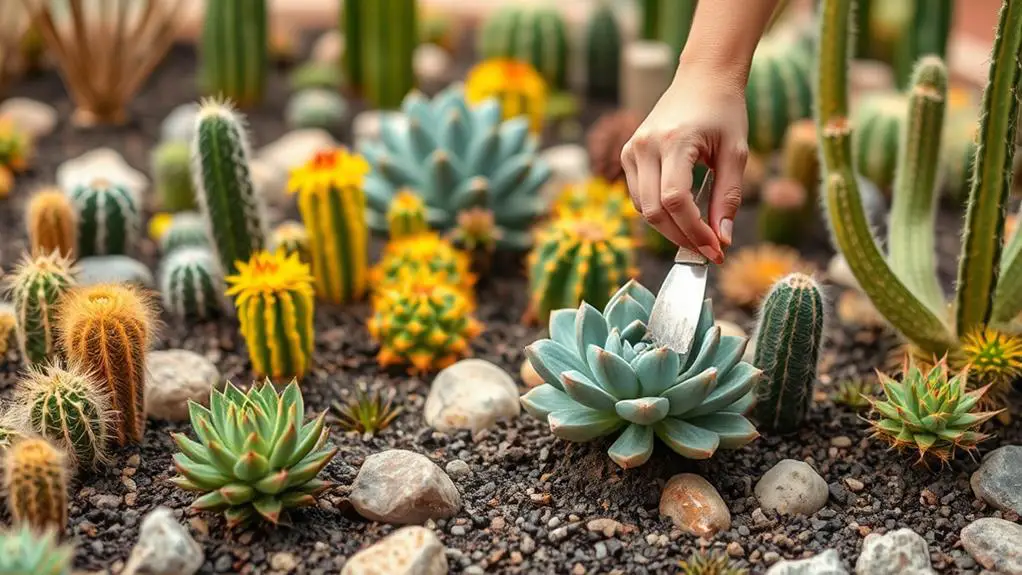
When planting your cacti and succulents, start with the largest plant first to create a balanced design and make room for the smaller ones.
Carefully prepare the roots by removing excess soil and gently massaging them to help them settle into their new home.
Use newspaper and tweezers to safely handle spiny cacti and position the roots correctly for both cacti and succulents.
Planting Order Tips
To create a stunning cacti and succulent arrangement, start by planting the largest plant first. This will help you establish a balanced design and guarantee that your display has a strong focal point.
Once you've placed the largest plant, position taller plants at the back and shorter ones in the front. This way, all your plants will get enough light and be easily visible.
When you plant cacti and succulents, remember that cacti need a bit of special attention. Bury their roots partially, leaving some exposed above the soil. This helps them stay healthy.
Use tweezers to handle delicate cacti during planting to avoid damaging their spines and structure.
Before planting, arrange your plants closely together. This not only maximizes space but also creates a visually appealing composition.
Don't worry about them being too close; they'll have room to grow. Following these planting order tips will set you up for success.
It might seem tricky at first, but with a bit of practice, you'll create beautiful, thriving cacti and succulent arrangements that you can be proud of.
Happy planting!
Root Preparation Methods
Proper root preparation is essential for the success of your cacti and succulent arrangements. Start by watering your plants a few days before repotting. This helps loosen the roots, making them easier to remove without causing damage.
Carefully inspect each plant for any signs of pests, diseases, or root rot. Trim away any damaged parts to promote healthy growth.
When you're ready to plant, remember that cacti and succulents need different approaches. For cacti, position them with their roots partially exposed above the soil. This enhances their health by preventing excessive moisture buildup.
On the other hand, cover succulent roots entirely to help retain moisture.
Use a scoop tool to place soil precisely around the exposed roots. This guarantees proper coverage and protects the roots while maintaining an aesthetically pleasing appearance.
Make sure to space out the plants appropriately. This allows for growth and airflow, preventing crowding and competition for resources.
Soil Placement Techniques**
Mastering soil placement techniques is essential for the healthy growth of your cacti and succulents. First, verify the soil you use is well-draining. This prevents water retention, which can lead to root rot, especially for cacti. A good mix often includes sand, perlite, or small gravel to keep the soil from getting too wet.
When planting, start with the largest plant to establish a balanced design. Use a scoop tool to place the soil carefully around the roots. For cacti, make sure their roots are partially exposed above the soil. This helps prevent excess moisture.
In contrast, succulent roots should be fully covered to retain the right amount of moisture. Adjust the soil level to support the plants, verifying there are no air pockets that could harm the roots. Adding or removing soil as needed helps achieve a balanced arrangement.
To further aid drainage, use drywall mesh tape at the bottom of your planter. This keeps soil in place while allowing water to flow out.
Soil Management

A essential aspect of growing healthy cacti and succulents is managing the soil they're planted in. Proper soil management starts with choosing the right mix. You should use a well-draining soil mix composed of equal parts potting soil, coarse sand, and perlite or pumice. This blend prevents water retention and promotes aeration, which is critical for both cacti and succulents.
Avoid heavy clay or compact soil, as it can suffocate roots and promote bacterial growth, leading to root rot. When planting your cacti, make sure their roots are partially exposed above the soil surface. This technique enhances their health by preventing excessive moisture around the base, which is a common issue.
To help retain soil while guaranteeing adequate drainage, apply a light layer of drywall mesh tape at the bottom of the pot. This simple step can make a big difference in keeping your plants happy and healthy.
Regularly check the soil moisture levels to make certain it remains dry but not bone dry. Adjust your soil mix as needed based on the specific watering needs of your plants. With these tips, you'll be well on your way to successfully growing beautiful cacti and succulents.
Watering Practices
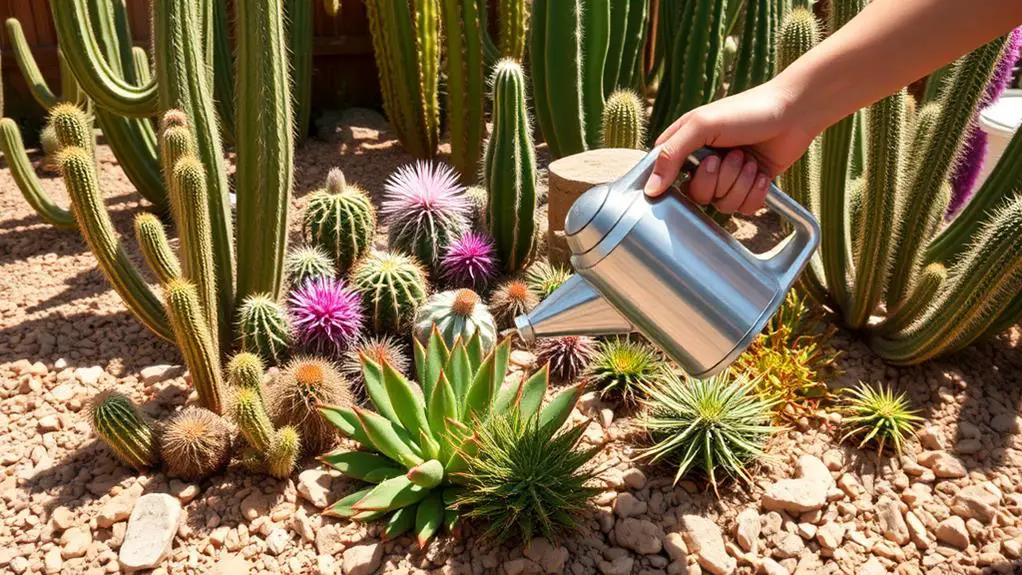
As you manage the soil for your cacti and succulents, understanding the right watering practices becomes equally important.
First, remember that cacti generally need less water than succulents. A good rule of thumb is to water them every 2-4 weeks, depending on the environmental conditions. Always check if the soil is dry to the touch before adding more water. Over-watering can cause root rot, especially in cacti, so it's better to be cautious.
Using a well-draining soil mix can prevent water retention. A combination of cactus soil, sand, and perlite works well. This mix helps water drain quickly, protecting your plants' roots.
Adjust your watering schedule based on the season. Many succulents and cacti enter dormancy in winter and need much less moisture during this time.
Environmental factors like light and humidity also play a big role in watering practices. Plants in high humidity areas might need less frequent watering compared to those in drier conditions.
Keep an eye on these factors and adjust accordingly. By following these care tips, you'll help your cacti and succulents thrive together, avoiding common pitfalls like over-watering.
Light Requirements
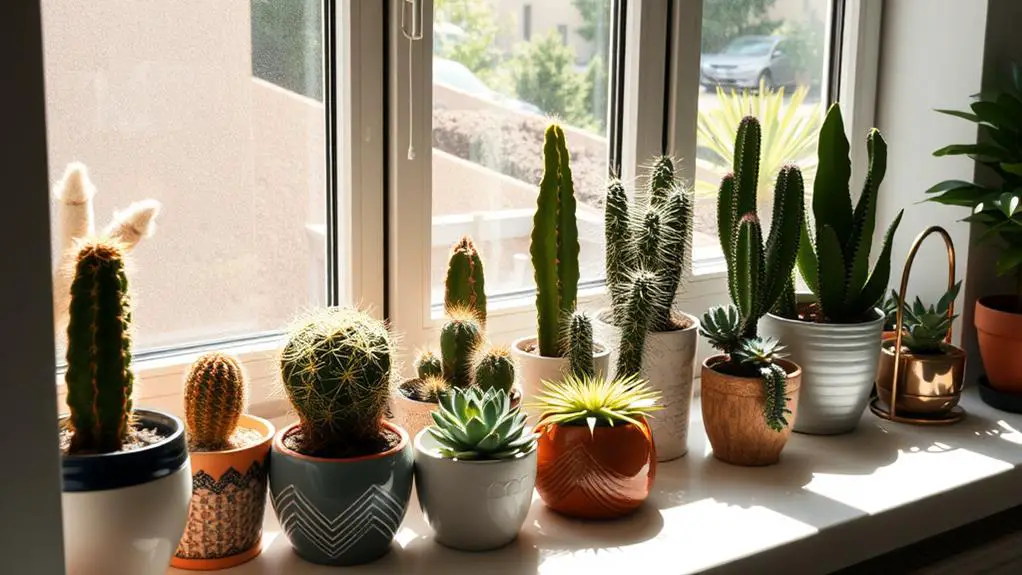
Understanding the light requirements for your cacti and succulents is essential for their health and growth.
While many of these plants love bright, indirect light, they can get sunburned if exposed to too much direct sunlight too quickly.
To help them thrive, gradually introduce them to more light, and remember to adjust their exposure with the changing seasons.
Optimal Light Levels
Ideal light levels are essential for the health and growth of cacti and succulents. These plants thrive in bright light, but it's important to strike the right balance to avoid stress. Most cacti and succulents do best with bright, indirect sunlight. While many species can handle full sun, sudden exposure can cause sunburn. Gradually introducing young cacti to direct sunlight helps them acclimate without damage.
In indoor settings, light exposure can vary. Unlike outdoor environments, indoor spaces may retain moisture longer, increasing the risk of rot if light levels are insufficient. Seasonal changes also impact light availability, so you might need to move your plants to sunnier spots during winter months to maintain their health.
Here's a handy table to help you understand the ideal light levels for different scenarios:
| Plant Type | Light Level | Notes |
|---|---|---|
| Young Cacti | Indirect Bright Light | Gradual exposure to direct sun |
| Mature Cacti | Full Sun | Monitor for sunburn |
| Indoor Succulents | Bright Indirect Light | Avoid overly damp conditions |
| Outdoor Succulents | Full Sun | Move as needed seasonally |
Avoid Direct Sunlight
Frequent exposure to direct sunlight can often be detrimental to cacti and succulents, leading to sunburn and damage to their leaves. Even though these plants enjoy bright light, too much direct sunlight can stress them out. It's vital to give them bright, indirect light instead. Sudden, intense sunlight can also increase the risk of infection and rot, which isn't good for your plants' health.
When you've got young cacti, gradually introduce them to direct sunlight. This slow acclimation helps them avoid shock. You might even want to use nurse plants to provide some shade until they mature. Nurse plants can offer the necessary protection, allowing young cacti and succulents to adapt more comfortably.
Don't forget to monitor the light exposure closely. Too much direct sunlight can stunt growth and make your plants unhappy. Checking on them regularly guarantees they're getting just the right amount of light.
Common Issues and Solutions
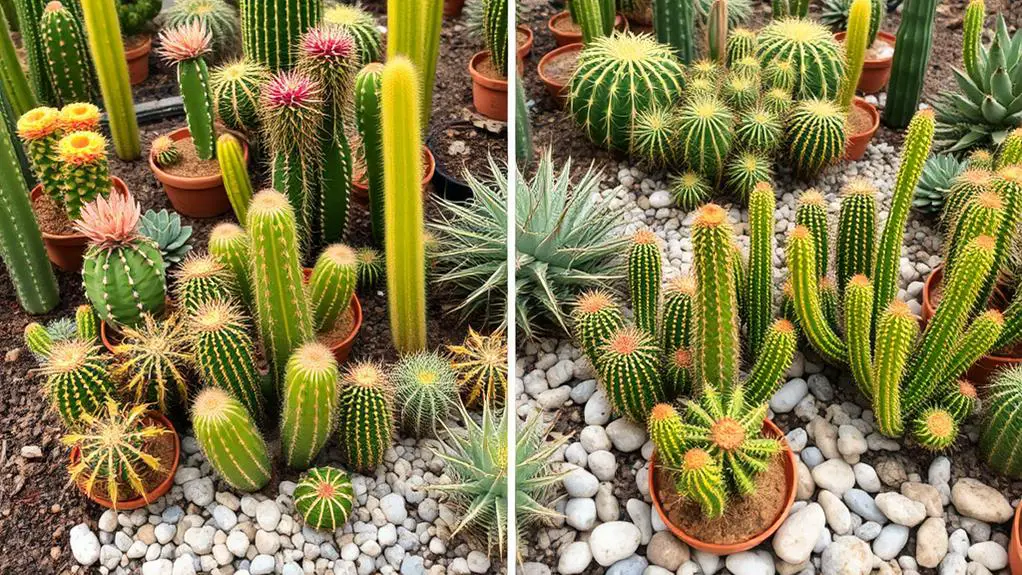
Caring for cacti and succulents can sometimes be tricky, especially when common issues arise. One of the most frequent problems is overwatering, which can lead to root rot. To prevent this, make certain your soil mix is well-draining and adjust your watering based on each plant's needs.
Pests like mealybugs and aphids can also be a nuisance. Regularly inspect your plants and use insecticidal soap to keep these pests at bay.
Here are some common issues and their solutions:
- Overwatering: Confirm your soil drains well and avoid watering too frequently. Let the soil dry out between waterings.
- Underwatering: Watch for signs of shriveling or stunted growth. Increase watering frequency if needed, particularly for thirstier succulents.
- Pests: Check your plants regularly for mealybugs and aphids. Treat infestations immediately with insecticidal soap.
- Fungal Infections: Promote good airflow by spacing plants properly and avoid watering the leaves directly.
- Nutrient Deficiencies: Feed your plants with diluted fertilizer every few weeks during the growing season to maintain vibrant growth.
Frequently Asked Questions
Can Succulents and Cactus Be Planted Together?
Yes, you can plant succulents and cacti together if they have similar watering needs and growing conditions. Use well-draining soil, choose complementary species, and make certain the container has drainage holes to prevent root rot.
How Do You Arrange Succulents and Cactus?
To arrange succulents and cacti, place taller plants at the back and shorter ones in front. Mix colors and textures, space them for growth, and layer different heights. Lay them out first to visualize the arrangement.
What Is the Rule of Cacti and Succulents?
You should remember that cacti need less frequent watering than many succulents. Both require well-draining soil and similar light conditions. Always use pots with drainage holes to prevent root rot and select compatible species.
Should Succulents Be Planted in Cactus Soil?
Yes, you can plant succulents in cactus soil. Just mix it with some potting soil or compost to retain a bit more moisture. Make certain the soil dries out between waterings to prevent root rot for both plants.
Conclusion
You've got this! Planting cacti and succulents together is a fun and rewarding project. Just remember to choose the right pot, use well-draining soil, and water sparingly. Give your plants bright, indirect light and keep an eye out for pests. With a little care and patience, your cacti and succulents will thrive and create a beautiful display. Enjoy the process and watch your indoor garden flourish!

